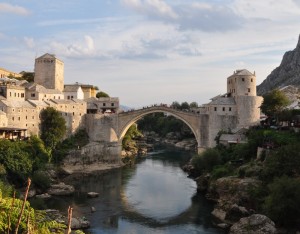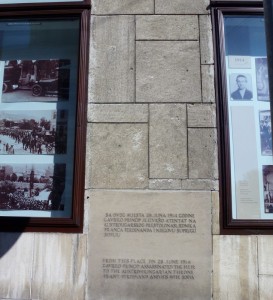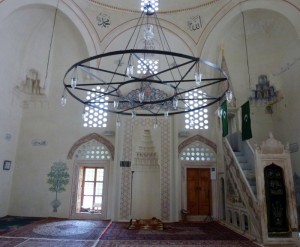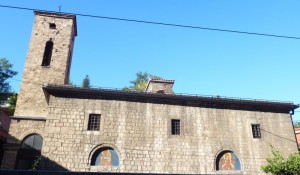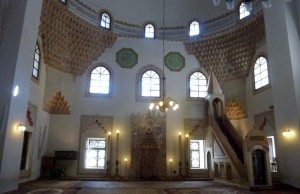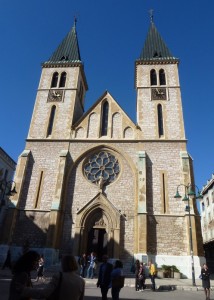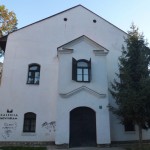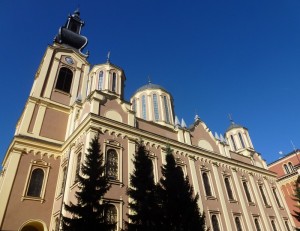Bosnia and Herzegovina (Bosnia) is a young nation with a rich but sad history. The assassination of Austrian Crown Prince Franz Ferdinand in Sarajevo in 1914 was the curtain raiser for the First World War. Bosnia’s declaration of independence from Yugoslavia 20 years ago led to a most gruesome and devastating war from March 1992 to December 1995. I took a glimpse of Sarajevo and Mostar on the 20th anniversary of this conflict.
Background
Bosnia and Herzegovina (Bosnia) has one of the richest histories in the Balkans. Slavic peoples first settled there from the 6th to 9th century. The principalities of Serbia and Croatia split control of Bosnia in the 9th and 10th century. Later the area was under the control of the Kingdom of Hungary and the Byzantine Empire.
In the early 12th century, Bosnia began to emerge as an independent state under the rule of local bans. The first independent banate in the region known as the Banate of Bosnia evolved into the Kingdom of Bosnia in the 14th century. It was annexed into the Ottoman Empire in1463. The Ottoman rule lasted for some four centuries and Bosnia was as an integral province of the Ottoman Empire with its historical name and territorial integrity. The Ottoman also introduced a number of key changes in the territory’s socio-political administration and Bosnia experienced a period of general welfare. Sarajevo and Mostar prospered and grew into regional centres with the construction of many major works.
The Ottoman Empire was on the wane while nationalism began to germinate in the 19th century. The first Bosnian uprising broke out in 1831 followed by other uprisings. Following widespread rebellions in the Balkans, the Congress of Berlin was convened leading to the Treaty of Berlin in 1878 under which jurisdiction for Bosnia was transferred to the Austro-Hungarian Empire. The territory was annexed in 1908.
Josip Broz Tito began organizing a resistance group and subsequently formed an Anti-Fascist Council of National Liberation in 1943. All major military offensives by the antifascist movement of Yugoslavia against Nazis and their local supporters were conducted in Bosnia and its people bore the brunt of fighting. More than 300,000 people died in Bosnia in WWII.
After the war, Bosnia and Herzegovina became one of six constituent republics of the Socialist Federal Republic of Yugoslavia. By 1970s a strong Bosnian political elite arose. With the fall of the Soviet Union and the start of the break-up of Yugoslavia, there was a growing demand for independence.
The Bosnia War
Bosnia sandwiched between Serbia and Croatia has been home to three ‘constituent peoples’ (ethnic groups) namely Muslim Bosniaks, Orthodox Serbs and Catholic Croats. On November 18, 1990, the first multi-party parliamentary elections were held which resulted in a national assembly dominated by three ethnically based parties. They formed a loose coalition and ousted the communists from power. Serbia and Croatia harboured designs for establishing Greater Serbia and Greater Croatia: President Milosevic of Serbia and President Tudman of Croatia reached the Karadordevo Agreement in 1991 splitting Bosnia between them.
Inside Bosnia, the situation became more delicate. While the Croats and Bosniaks Members of Parliament (MP) sought independence, the Serbian MPs preferred to stay with the Yugoslav Federation. The Serb Democratic Party members formed the Assembly of Serb People of Bosnia and Herzegovina in October 1991 and the Serbian Republic of Bosnia and Herzegovina in January 1992. Bosnia Muslims and Croats fearing the drive for a Greater Serbia called for a referendum for Bosnia independence which was boycotted by the Bosnian Serb population. The majority who voted was in favour of independence which was proclaimed on March 3, 1992.
 Bosnian Serbs supported Milosevic’s plan for creating a Greater Serbia through ethnic cleansing. On April 6, 1992, Bosnian Serbs began their siege of Sarajevo which lasted 43 months. More than 12,000 residents were killed. Throughout Bosnia, Bosnia Serbs and the Yugoslav National Army (JNA) also began a systematic policy of ‘ethnic cleansing’. The worst atrocity was the massacre of 8,000 Muslim men and boys by Bosnia Serb forces near the town of Srebrenica in July 1995 under the command of General Ratko Mladić.
Bosnian Serbs supported Milosevic’s plan for creating a Greater Serbia through ethnic cleansing. On April 6, 1992, Bosnian Serbs began their siege of Sarajevo which lasted 43 months. More than 12,000 residents were killed. Throughout Bosnia, Bosnia Serbs and the Yugoslav National Army (JNA) also began a systematic policy of ‘ethnic cleansing’. The worst atrocity was the massacre of 8,000 Muslim men and boys by Bosnia Serb forces near the town of Srebrenica in July 1995 under the command of General Ratko Mladić.
It is estimated that some 100,000- 110,000 out of a population of 4.4 million were killed, more than 200,000 Bosnians were injured and two million people were displaced. Many villages, major infrastructures and 60% of all houses damaged or destroyed.
The major players in this conflict include Serbia, Bosnia Serbs, Croatia and Bosnia. The United Nations (UN) and NATO also played an important role at various stages of the conflict. In April 1993, NATO commenced operation ‘deny flight’ to enforce a no-fly zone. In May 1993, the International Criminal Tribunal for the former Yugoslavia was established as a body of the UN to prosecute war crimes committed during the Yugoslav wars.
The war finally ended with the signing of the Dayton Peace Agreement on December 14, 1995 in Paris by President Milosevic, President Tudjman and President Izetbegovic of Bosnia (who was head of the Muslim-dominated party of Democratic Action). The Agreement affirmed Sarajevo as the capital of Bosnia but carved the country into two autonomous and ethnically based entities namely a Bosnia-Croat Federation and a Serb Republic Srpska.
Reconstruction has been taken place since 1995. Today, Bosnia has a population of 4 million of which 48% is Bosniaks, 37% Serbs and 14% Croats. It has two World Heritage Sites namely the old bridge area of the old city of Mostar and the Mehmed Pasa Sokolovic Bridge in Višegrad.
October 6 (Saturday): Drvengrad, Serbia – Sarajevo, Bosnia and Herzegovina – Mostar (220km)
 I was on Bosnia and Herzegovina soil around noon. The ride to Sarajevo took two hours. The scenery of the first hour of the journey was fantastic: we drove next to the River Drina with gorges, beautiful mountains and autumn colours. I also had a distant view of the Mehmed Pasa Sokolovic Bridge.
I was on Bosnia and Herzegovina soil around noon. The ride to Sarajevo took two hours. The scenery of the first hour of the journey was fantastic: we drove next to the River Drina with gorges, beautiful mountains and autumn colours. I also had a distant view of the Mehmed Pasa Sokolovic Bridge.
My original plan was to spend the first night in Sarajevo and the second in Mostar and to meet up with Rani and Nilly who would be arriving on the same day by air from Sofia. I would continue my journey to Albania through Montenegro (I made a side trip to Kotor, Podgoric (the capital) and Buda during my visit to Croatia in 2005) or to Kosovo through Novi Pazar, Serbia. The routing would depend on availability and timing of the bus.
I however made two poor decisions because of inertia.
First I planned to get off at Sarajevo. But on the way to the capital, one of the passengers, an old lady from Mostar and the driver suggested me go to Mostar first. I followed her advice and arrived in Mostar before 4pm.
Second, I got a nice room for 30euro at the Shangri-La B&B recommended by Yan (whom I met in Sofia) and did not want to move. So I stayed there for two nights and could only spend nine hours in Sarajevo before leaving for Kosovo.
I found out that there is only one bus leaving Mostar at 7am for Herceg Novi, Kotor and Buda in Montenegro. Though there must be a way to get to Albania by road (or by sea), I did not want to take risk as I had to be in Milan by October 15 and fly back to Hong Kong on October 17. I therefore decided to take the evening bus from Sarajevo to Novi Pazar, Serbia on October 8 (where there is a connecting bus to Pristina, Kosovo).
Mostar, the largest and one of the most important cities in the Herzegovina region, was first mentioned in 1474. Between 1992 and 1993, Mostar was under siege for 18 months and was heavily shelled. After the war, great progress has been made in the reconstruction of the city which has been under the direct monitoring from a European Union (EU) envoy.
 |
 |
I strolled along the cobbled stone alleys aimlessly enjoying the tranquil and picturesque old town. I entered the courtyard of the Koski Mehmed Pasha Mosque (1617) which offers the best view of the Old Bridge measuring 28m long and 20m high. It was erected in 1566 on the orders of Suleiman the Magnificent and is the city’s symbol. It is considered one of the most exemplary pieces of Islamic architecture in the Balkans. The Bridge destroyed by the Croatia Defence Council was rebuilt and reopened in July 2004.
October 7: Mostar- Medugorje – Mostar (60km)
As there was no local public bus to Medugorje on Sunday, Nurmin, owner of Shangri-La B&B introduced me to Miho, a tour guide who drove me there for 25euro.
 |
Medugorje has become a pilgrimage site when six teenagers claimed they had seen a miraculous apparition of Virgin Mary on June 24, 1981 (the first in Lourdes, France in 1858 and in Fatima, Portugal in 1917). ‘Religious tourism’ has brought fame and prosperity to this town which receives several thousands of pilgrims a day.
 |
 |
 |
 |
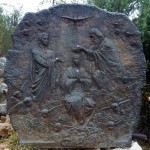 |
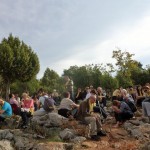 |
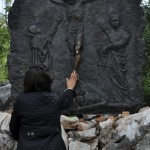 |
I visited St James Church which has a huge pavilion with seats for outdoor service. I then proceeded to the Apparition Hill. The path leading to the place where Virgin Mary was supposedly seen had some sharp and pointed outcrops of rocks. There were a lot of pilgrims and some walked bare-footed. I also followed the trail with a dozen sculptures depicting the life story of Jesus and Virgin Mary and watched groups of pilgrims praying. But I missed the Cross Mountain where there is a white-cross planted in 1934 to commemorate the 1900th anniversary of Christ’s death.
Milo spoke good English and showed me the memorial for 11 Spanish soldiers who were killed during the conflict. I have learnt that life is difficult with a high unemployment rate. Many Bosnians have relatives as guest workers overseas: they live in big houses and live on remittance.
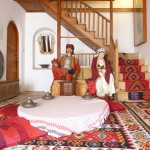 |
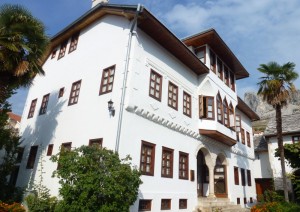 |
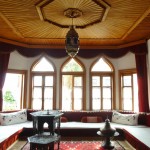 |
Once back in Mostar, I went to the Franciscan Church on the Christian (western) side of Old Bridge. The church is bare without much decoration. Packed with Sunday church-goers, it had a warm and welcoming ambience. I had meat fingers, sweetbread and a bottle of red wine at a local restaurant which only cost me 10euro. Good value!
Nurmin suggested I visit the Muslibegovic House built in the 17th century, one of the most representative monuments of the Ottoman residential architectural in the country – upper storey for residential use, hall, paved courtyard and verandah on one or two storeys. This beautiful and elegant house has been turned into a boutique hotel which charges 80euro a night.
My next stop was the Karadjobey Mosque (1557) where I climbed 95 steps to the top to take a panoramic view of the city. Finally I visited a Turkish House-Museum.
 |
I sat for a long time in the terrace next to the Koski Mehmed Pasha Mosqueto and watched the afternoon golden rays lighting up the bridge. I met Thomas, an Englishman who has been on the road for eight weeks covering 17 countries from the Baltic to the Balkans. He gave me tips about travelling in Kosovo, Macedonia and Albania.
 |
 |
I felt relaxed but the sight of bombed schools and houses reminded me of the atrocity taking place in this laid-back old town just 20 years ago. I took my last stroll along both sides of the bridge before going back to the B&B without dinner: I was not hungry.
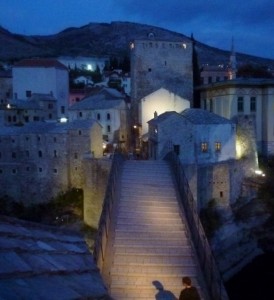 |
 |
October 8 (Monday): Mostar-Sarajevo, Bosnia and Herzegovina – Novi Pazar, Serbia (70km by train and 390km by bus)
I took the 8:02am train and arrived in Sarajevo at 10:30am. The ticket only cost 5euro. I then brought a 10pm bus ticket to Novi Pazar, Serbia.
 |
 |
 |
The charge for luggage storage at the bus terminal is exorbitant: 2euro for the first hour and 1euro per hour thereafter. I therefore took my luggage to Europe Hotel where I would be meeting Nilly and Rani for dinner and left it there.
 Sarajevo was founded by the Ottoman Empire in the 1450s. 1461 was used as the city’s founding date. The city grew with a population of over 80,000 (the biggest and most important city in the Balkans after Istanbul) during the reign of the second governor Gazi Husrev Beg. During the Great Turkish War, the city was burnt and destroyed by the Habsburg force in 1697. In the 1830s, several battles of the Bosnian uprising took place around the city.
Sarajevo was founded by the Ottoman Empire in the 1450s. 1461 was used as the city’s founding date. The city grew with a population of over 80,000 (the biggest and most important city in the Balkans after Istanbul) during the reign of the second governor Gazi Husrev Beg. During the Great Turkish War, the city was burnt and destroyed by the Habsburg force in 1697. In the 1830s, several battles of the Bosnian uprising took place around the city.
During the Austro-Hungarian period (1878-1914), the city underwent rapid development being used as a testing ground for new inventions. The tramways were established there in 1885 before installing in Vienna. Sarajevo has a unique blend of an Ottoman city market and contemporary western architecture. The city has some fine examples of Secession- and Pseudo-Moorish styles that date from this period. For the first time in history, its population began writing in Latin script.
During the 43-month of siege of Sarajevo from 1992-95, Bosnia Serbs who declared a new ‘Republic Srpska’ supported by JNA stationed in the surrounding hills and assaulted the city with weapons. Over 11,000 people died and 56,000 wounded. Before the war, the city was a multi-racial and –cultural city with the nickname of ‘Europe’s Jerusalem’ (49% Bosniaks, 30% Serbs, 10% Yugoslavs and over 6% Croats). By 2002 some 80% of the population in the Sarajevo canton was Bosinaks, 11% Serbs and 6% Croats.
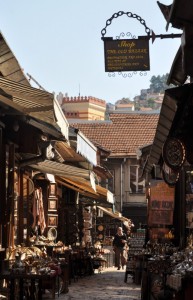 |
 |
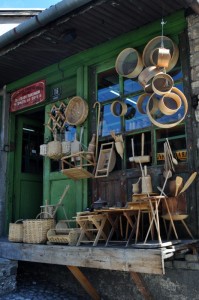 |
The old town of Sarajevo is compact and most charming. The city has reconstructed since 1995 and not many bombed structures remain today. I strolled leisurely from the caravanserai Kolobara-han (next to the Europe Hotel) to Baščaršija (the Turkish Quarter), the heart of old Sarajevo with plenty of pigeons and stopped by the Gazi Husrev Bey Mosque (1531). One street is filled with bronze artisans plying their trade and cafes serving traditional Bosnia coffee liven up the old town. A teahouse with simple but attractive decoration caught my attention. I went in and had a local herbal drink which is sour and cold. Not my cup of tea!
I walked along the Miljacka River to the National and University Library of Bosnia and Herzegovina (which once served as the city hall) built in Pseudo-Moorish style .It was destroyed in 1992 and restoration will be completed in 2014. I crossed the river to see the Emperor’s Mosque (1457), the largest single-subdome mosque in the country and an important landmark in Sarajevo. It was time for praying and I stayed in the women’s quarter to watch the pious Muslims praying for 15 minutes. It was the first time I had stayed through a praying session in a mosque. A young man who speaks English hoped I could better understand his ‘powerful’ religion. I do not know what he means by ‘powerful’. In any case, I respect all religions and believe in religious freedom and peaceful co-existence.
 |
Not far from the mosque is the Ashkenazi Synagogue the third largest synagogue in Europe. It was built in 1902 in a Pseudo-Moorish style. I could not find the entrance and decided to find the red Franciscan Church of St Anthony of Pauda built in 1904 in a neo-gothic style. But when I reached the Latin Bridge which was first built in the 16th century and became world famous for the infamous assassination of Archduke Franz Ferdinand and his wife in 1914, I decided to cross the river.
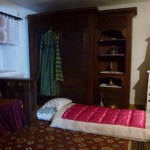 My next stop was the Despić Kuća, a house museum of Hatji Makso Despić. He was a rich man and patron of theatre and art. The house, its design and decoration gives a glimpse of the life of the rich. But what I enjoy most is his testament written in March 1921 giving detailed instruction to his family what he would wear, how his corpse would be carried to the church, how he should be buried and how money should be given to the poor. Clause 14 reads inter alia, “It is the custom for the barber to shave the deceased, to powder him, whiten his face and rouge his cheek and lips, and dress him in a frock coat with patent leather shoes and black trousers, as if going to a ball, may God forbid – this shall not happen to Makso”. Like him, I should spell out my wish and make preparation as one never knows when the day will come.
My next stop was the Despić Kuća, a house museum of Hatji Makso Despić. He was a rich man and patron of theatre and art. The house, its design and decoration gives a glimpse of the life of the rich. But what I enjoy most is his testament written in March 1921 giving detailed instruction to his family what he would wear, how his corpse would be carried to the church, how he should be buried and how money should be given to the poor. Clause 14 reads inter alia, “It is the custom for the barber to shave the deceased, to powder him, whiten his face and rouge his cheek and lips, and dress him in a frock coat with patent leather shoes and black trousers, as if going to a ball, may God forbid – this shall not happen to Makso”. Like him, I should spell out my wish and make preparation as one never knows when the day will come.
 |
 |
I wanted to join a tour to visit the ‘Tunnel of Hope’ which is located underneath the runway at the airport where the citizens of Sarajevo got supplies during the siege. But I was 20 minutes late and the group had left. Instead, I spent the next two hours visiting the Gazi Husrev Bey’s Mosque; the Cathedral of Jesus’ Sacred Heart (1889) built in a neo-gothic style with impressive decoration, and the Congregational Church of the Holy Mother (1868), the largest Orthodox Church in the city. My last stop was the Old Serbian Orthodox Church of St Michael the Archangel dating back to the Middle Ages. The foundations and its strange inner architectural constructions with two-storied arcades came early Christian times (5th or 6th century). It is unique for its atypical architecture full of icons and religious relics.
 |
I joined a 2-hour walking tour at 4:30pm. We started at the place where the infamous assassination took place on June 28, 1914. We crossed the Latin Bridge to reach the Emperor’s Mosque where the guide talked about the beginning of the Ottoman era in the 15th century. The next stop was the National Library before arriving at Baščaršija. He pointed out the restaurant where former US President Clinton had dinner before taking us to the Gazi Husrev Bey’s Mosque. I have now a better understanding on the importance of Gazi Husrev Bey’s reign in shaping up the city.The Sarajevo Museum and the National Museum are on my list. Sadly I did not have time to visit the first while the latter has been closed owing to lack of funds.
We went to the Cathedral of Jesus’ Sacred Heart, the Jewish synagogue (now a museum) and the Congregational Church of the Holy Mother. He kept emphasizing that people of different religion are now living in peace. We saw the Central Market before ending the tour at the eternal flame commemorating WWII.
 |
The weather had changed: it was freezing. I rushed back to Europe Hotel to get a down jacket. I rejoiced to see Nilly and Rani at 7pm and we had dinner in the restaurant Bill Clinton had dined. The waiter recommended us to try several local dishes. The local cuisine is wholesome and reasonably priced. The dinner for three only cost 25euro.
It was time to say good-bye to my good friends, Nilly and Rani. I would miss their company and laughter when I was on my own again. I hope to visit Israel next year and meet up with them somewhere as they are world travellers!
My bus was full and departed at 10pm. I got my ticket for Pristine, Kosovo on the bus for 17euro. We arrived at the border around midnight. As usual, we stayed in the bus and the immigration officer came up to take our passports/ID cards.
After entering the Serbian side, the bus stopped in a cafeteria nearby for half an hour. I was exhausted and fell asleep before the bus moved again.
Remarks
 |
 |
 |
I like history and Sarajevo has been on my list for some 40 years. My first chance to visit Mostar and Sarajevo was in 2005 when I was on a tour in Croatia. But the situation was not stable and we were advised not to go. I should have spent two nights in Sarajevo instead of Mostar soaking in its unique ambience.The Bosnia War has been the most devastating conflict in Europe since WWII. The country has been a victim of the ambition of its Croatian and Serbian neighbours. The country has been destroyed and is split into two entities namely the Federation of Bosnia and Herzegovina and the Republic of Srpska. Those who have committed war crimes and act of genocides are still on trial in The Hague. It is sad to say that the country 20 years after the conflict seems more segregated along ethnical and religious lines. So what has the war achieved?
I like Bosnia which is mountainous and picturesque with beautiful gorges, rivers, rich vegetation and green pasture. The Bosnians I met are simple, genuine and nice.
I am keen to find out how Bosnians cope psychologically after catastrophic experiences during the war. The guide in Sarajevo is a Muslim and he vows that he would not let his children go to war. He is young and able to look ahead. But I am not sure if the war scar can be healed easily. I love to come again and to better understand the country and its people.


